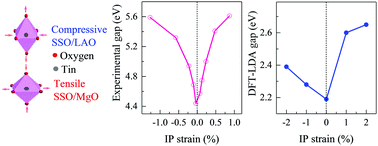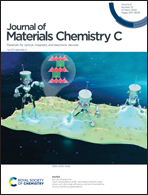Wide range bandgap modulation in strained SrSnO3 epitaxial films†
Abstract
Strain effects on the structure and bandgap of SrSnO3 (SSO) films epitaxially grown on (001)-orientation LaAlO3 (LAO) and MgO substrates by pulsed laser deposition were investigated via experiment and density functional theory (DFT) simulation approaches. High-resolution X-ray diffraction analysis revealed that in-plane (IP) biaxial compressive and tensile strains increase gradually for SSO films on LAO(001) and MgO(001) substrates with decreasing film thickness, respectively. The optical bandgaps of SSO films increase from 4.44 to 5.59 eV on LAO substrates and from 4.57 to 5.61 eV on MgO substrates with a decrease in the film thickness, which were measured by optical transmittances. X-ray photoelectron spectroscopy was used to measure the surface chemical states of SSO films and it was found that the increase of IP tensile strain would increase the concentration of oxygen vacancies (VOs). Calculations based on DFT showed that IP compressive strain lifts the Sn 5s orbitals to a higher energy level, and IP tensile strain results in lowering of the valence band, thereby widening the bandgap which are consistent with our experimental results. These results suggest that the strained SSO epitaxial films possessing a wide range bandgap tuning may have potential applications in field effect transistors and solar cells.



 Please wait while we load your content...
Please wait while we load your content...